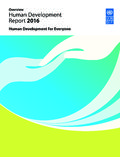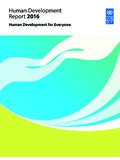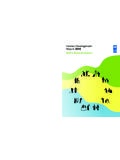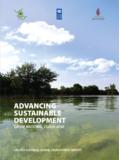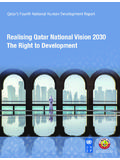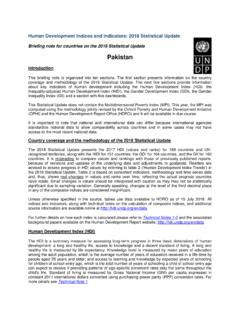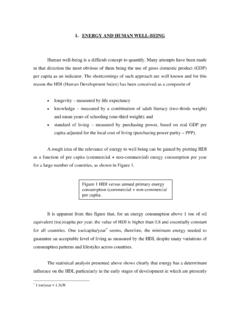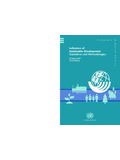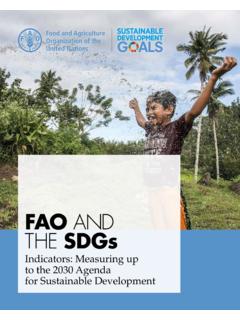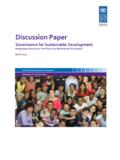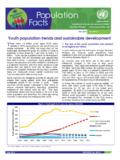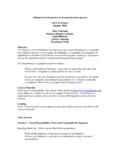Transcription of Human Development Report 2016: Human …
1 Statistical annexReaders guide 193 Statistical tablesHuman Development composite indices1 Human Development Index and its components 1982 Human Development Index trends, 1990 2015 2023 Inequality-adjusted Human Development Index 2064 Gender Development Index 2105 Gender Inequality Index 2146 Multidimensional Poverty Index: developing countries 218 Human Development indicators7 Population trends 2228 Health outcomes 2269 Education achievements 23010 National income and composition of resources 23411 Work and employment 23812 Human security 24213 International integration 24614 Supplementary indicators: perceptions of well-being 25015 Status of fundamental Human rights treaties 254 Human Development dashboards1 Life-course gender gap 2592 Sustainable Development 264 Regions 269 Statistical references 270 Statistical annex | 191 Human Development Report 2016 Human Development for EveryoneReaders guideThe 17 statistical tables in this annex provide an overview of key aspects of Human Development .
2 The first six tables contain the family of composite Human Development indices and their components estimated by the Human Development Report Office (HDRO). The remaining tables present a broader set of indicators related to Human Development . The two dashboards introduce partial groupings of countries according to their performance on each otherwise noted, tables use data available to the HDRO as of 1 September 2016. All indices and indicators, along with technical notes on the calculation of composite indi-ces and additional source information, are available at and territories are ranked by 2015 Human Devel-opment Index (HDI) value. Robustness and reliability analysis has shown that for most countries differences in HDI are not statistically significant at the fourth decimal place. For this rea-son countries with the same HDI value at three decimal places are listed with tied and definitionsUnless otherwise noted, the HDRO uses data from interna-tional data agencies with the mandate, resources and expertise to collect national data on specific of indicators and sources for original data com-ponents are given at the end of each table, with full source details in Statistical updatesThe 2016 Report retains all the composite indices from the family of Human Development indices the HDI, the Inequality- adjusted Human Development Index (IHDI), the Gender Development Index (GDI), the Gender Inequality Index (GII) and the Multidimensional Poverty Index (MPI).
3 The methodology used to compute these indices is the same as the one used in the 2015 Report . See Technical notes 1 5 at for in this year s Report are two colour-coded dashboard tables, Life-course gender gap and Sustainable Development . The dashboards introduce partial grouping of countries by their performance on each over time and across editions of the ReportBecause national and international agencies continually improve their data series, the data including the HDI values and ranks presented in this Report are not comparable to those published in earlier editions. For HDI comparability across years and countries see table 2, which presents trends using consistent between national and international estimatesNational and international data can differ because interna-tional agencies harmonize national data using a consistent methodology and occasionally produce estimates of missing data to allow comparability across countries.
4 In other cases international agencies might not have access to the most recent national data. When HDRO becomes aware of discrepancies, it brings them to the attention of national and international data groupings and aggregatesThe tables present weighted aggregates for several country groupings. In general, an aggregate is shown only when data are available for at least half the countries and represent at least two-thirds of the population in that classification. Aggregates for each classification cover only the countries for which data are Development classificationHDI classifications are based on HDI fixed cutoff points, which are derived from the quartiles of distributions of the component indicators. The cutoff points are HDI of less than for low Human Development , for medium Human Development , for high Human develop-ment and or greater for very high Human groupingsRegional groupings are based on United Nations Development Programme regional classifications.
5 Least developed countries and small island developing states are defined according to UN classifications (see ).Readers guide | 193 Developing countriesAggregates are provided for the group of all countries classified as developing countries, grouped by for Economic Co-operation and DevelopmentOf the 35 OECD members, 32 are considered developed and 3 developing (Chile, Mexico and Turkey). Aggregates refer to all countries from the group for which data are noteData for China do not include Hong Kong Special Administra-tive Region of China, Macao Special Administrative Region of China or Taiwan Province of dash between two years, as in 2005 2014, indicates that the data are from the most recent year available during the period specified. A slash between years, as in 2005/2014, indicates that data are the average for the years shown. Growth rates are usually average annual rates of growth between the first and last years of the period following symbols are used in the tables.
6 Not available0 or Nil or negligible Not applicableStatistical acknowledgementsThe Report s composite indices and other statistical resources draw on a wide variety of the most respected international data providers in their specialized fields. HDRO is particularly grateful to the Centre for Research on the Epidemiology of Disasters; Economic Commission for Latin America and the Caribbean; Eurostat; Food and Agriculture Organization; Gallup; ICF Macro; Institute for Criminal Policy Research; Internal Displacement Monitoring Centre; International Labour Organization; International Monetary Fund; Inter-national Telecommunication Union; International Union for the Conservation of Nature; Inter-Parliamentary Union; Luxembourg Income Study; Office of the United Nations High Commissioner for Human Rights; Office of the United Nations High Commissioner for Refugees; Organisation for Economic Co- operation and Development ; Socio-Economic Database for Latin America and the Caribbean; Syrian Center for Policy Research; United Nations Children s Fund; United Nations Conference on Trade and Development .
7 United Nations Department of Economic and Social Affairs; United Nations Economic and Social Commission for West Asia; United Nations Educational, Scientific and Cultural Organ-ization Institute for Statistics; United Nations Entity for Gender Equality and the Empowerment of Women; United Nations Office on Drugs and Crime; United Nations Relief and Works Agency for Palestine Refugees in the Near East; United Nations World Tourism Organization; World Bank; and World Health Organization. The international education database maintained by Robert Barro (Harvard University) and Jong-Wha Lee (Korea University) was another invaluable source for the calculation of the Report s tablesThe first six tables relate to the five composite Human develop-ment indices and their the 2010 Human Development Report , four composite Human Development indices the HDI, the IHDI, the GII and the MPI for developing countries have been calculated.
8 The 2014 Report introduced the GDI, which compares the HDI calculated separately for women and men. The remaining tables present a broader set of Human develop-ment indicators and provide a more comprehensive picture of a country s Human 1, Human Development Index and its components, ranks countries by 2015 HDI value and details the values of the three HDI components: longevity, education (with two indicators) and income. The table also presents the difference in rankings by HDI and gross national income per capita, as well as the ranking on the 2014 HDI, calculated using the most recently revised historical data available in 2, Human Development Index trends, 1990 2015, provides a time series of HDI values allowing 2015 HDI values to be compared with those for previous years. The table uses the most recently revised historical data available in 2016 and the same methodology applied to compute 2015 HDI values. The table also includes the change in HDI rank over the last five years and the average annual HDI growth rate across four time intervals: 1990 2000, 2000 2010, 2010 2015 and 1990 3, Inequality-adjusted Human Development Index, contains two related measures of inequality the IHDI and the loss in HDI due to inequality.
9 The IHDI looks beyond the average achievements of a country in longevity, education and income to show how these achievements are distributed among its residents. An IHDI value can be interpreted as the level of Human Development when inequality is accounted for. The rela-tive difference between IHDI and HDI values is the loss due to inequality in distribution of the HDI within the country. The table also presents the coefficient of Human inequality, which 19 4 | Human Development Report 2016is an unweighted average of inequalities in three dimensions. In addition, the table shows each country s difference in rank on the HDI and the IHDI. A negative value means that taking inequality into account lowers a country s rank on the HDI. The table also presents three standard measures of income inequality: the ratio of the top and the bottom quintiles; the Palma ratio, which is the ratio of income of the top 10 percent and the bottom 40 percent; and the Gini 4, Gender Development Index, measures disparities on the HDI by gender.
10 The table contains HDI values estimat-ed separately for women and men; the ratio of which is the GDI value. The closer the ratio is to 1, the smaller the gap between women and men. Values for the three HDI components longevity, education (with two indicators) and income are also presented by gender. The table includes five country group-ings by absolute deviation from gender parity in HDI 5, Gender Inequality Index, presents a composite measure of gender inequality using three dimensions: reproduc-tive health, empowerment and the labour market. Reproductive health is measured by two indicators: the maternal mortality ratio and the adolescent birth rate. Empowerment is measured by the share of parliamentary seats held by women and the shares of population with at least some secondary education by gender. And labour market is measured by participation in the labour force by gender. A low GII value indicates low inequality between women and men, and 6, Multidimensional Poverty Index: developing countries, captures the multiple deprivations that people in developing countries face in their education, health and living standards.
